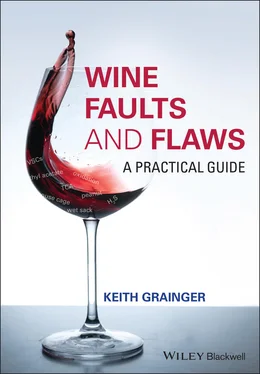Keith Grainger - Wine Faults and Flaws
Здесь есть возможность читать онлайн «Keith Grainger - Wine Faults and Flaws» — ознакомительный отрывок электронной книги совершенно бесплатно, а после прочтения отрывка купить полную версию. В некоторых случаях можно слушать аудио, скачать через торрент в формате fb2 и присутствует краткое содержание. Жанр: unrecognised, на английском языке. Описание произведения, (предисловие) а так же отзывы посетителей доступны на портале библиотеки ЛибКат.
- Название:Wine Faults and Flaws
- Автор:
- Жанр:
- Год:неизвестен
- ISBN:нет данных
- Рейтинг книги:4 / 5. Голосов: 1
-
Избранное:Добавить в избранное
- Отзывы:
-
Ваша оценка:
- 80
- 1
- 2
- 3
- 4
- 5
Wine Faults and Flaws: краткое содержание, описание и аннотация
Предлагаем к чтению аннотацию, описание, краткое содержание или предисловие (зависит от того, что написал сам автор книги «Wine Faults and Flaws»). Если вы не нашли необходимую информацию о книге — напишите в комментариях, мы постараемся отыскать её.
FLAWS
Wine Faults and Flaws: A Practical Guide
An essential guide to the faults and flaws that can affect wine
Wine Faults and Flaws — читать онлайн ознакомительный отрывок
Ниже представлен текст книги, разбитый по страницам. Система сохранения места последней прочитанной страницы, позволяет с удобством читать онлайн бесплатно книгу «Wine Faults and Flaws», без необходимости каждый раз заново искать на чём Вы остановились. Поставьте закладку, и сможете в любой момент перейти на страницу, на которой закончили чтение.
Интервал:
Закладка:
Table 2.4 Compounds contributing to the varietal aromas of Sauvignon Blanc wines.
| Aroma | Thiol | Sensory detection threshold a) |
|---|---|---|
| Boxwood – broom, cat's pee | 4‐Mercapto‐4‐methylpentan‐2‐one | 0.8–3.3 ng/l |
| Citrus zest and peel | 4‐Mercapto‐4‐methylpentan‐2‐ol | 55 ng/l |
| Grapefruit, passion fruit | 3‐Mercaptohexan‐1‐ol | 60 ng/l |
| Mango, guava, passion fruit | 3‐Mercaptohexyl acetate | 4 ng/l |
| Cut grass | 1‐hexanol | 4.5 μg/l |
| Smoke, gunflint | Benzenemethanethiol | 0.3 ng/l |
| Aroma | Methoxypyrazine | Sensory detection threshold a) |
| Green pepper, grass | 2‐methoxy‐3‐isobutyl pyrazine (iBMP) | 1–2 ng/l |
a)Sensory detection thresholds depend upon many criteria, including the presence of other compounds and the wine matrix. The figures stated have been extrapolated from numerous sources.
It may sometimes be helpful for the taster to consider wine aromas in basic groups:
Fruits (primary aromas);
Flowers (primary aromas);
Spices (primary, secondary, and tertiary aromas);
Vegetables (primary and tertiary aromas);
Oak aromas (secondary aromas);
Other aromas.
Of course, it is possible to divide each of these basic groups into subgroups. For example, the fruits group might be divided into citrus, green, red, stone, and tropical fruits. Dried fruits may also be included. Each subgroup contains individual aromas and flavours.
All aromas detected during nosing should be noted, and when detailing individual descriptors, these may be linked to known varietal characteristics. For example, green apple, lime, peach, and mango are just some of the aromas that may be associated with Riesling. Strawberry, raspberry, red cherry, green leaf, and mushroom are typical aromas associated with Pinot Noir. The detection of any oak related aromas including vanilla, toast, nuts, and coconut may warrant interpretation (barrels/beans/chips?).
2.7 Palate
2.7.1 Palate Sensations
Palate is a convenient expression to describe the sensations a wine gives once in the mouth. Palate may comprise a ‘complex combination of the olfactory, gustatory, and trigeminal sensations’ [7]. In this part of the tasting process, we assess the taste and tactile sensations detected in the mouth, particularly on the tongue, and the flavour characteristics detected as a result of the wine's volatile compounds being breathed through the retro‐nasal passage at the back of the mouth and transmitted to the olfactory bulb. The impressions of aromas sensed retro‐nasally are often different from those sensed nasally. The sensory cells within the mouth are mostly contained within the 5000 or more taste buds on the tongue – young people may have up to 10 000 active taste buds. There are also taste buds on the roof of the mouth and the back of the throat, which is why some people claim to only get 100% of what the wine has to offer if they swallow rather than spit. Interestingly, a recent study has indicated that olfactory receptors are functionally expressed in taste papillae [11]. In other words, it may be possible for the tongue to ‘smell’.
A reasonable quantity of wine should be taken into the mouth. If it is too little, the wine will be diluted and modified by saliva. It is important to breathe air through the wine in the mouth to vaporise the volatile compounds. Accordingly, a free passage is needed to and from the nose to enable transmission of these aromas. If a person has a blocked nose, it is not just the sense of smell that disappears, but most of the sense of taste. The taste sensations can be increased if we breathe out via the nose after we have spat out the wine, and this action will help determine the ‘finish’ of the wine.
As we taste, chew, and dissect the wine in the mouth, before finally spitting, numerous sensations develop. This evolution is considered in stages. The initial attackis the sensation as the wine taken into the mouth. This is followed by the developmenton the palate where we perceive the flavour characteristics and intensity, and then the finishwhich comprises the final impressions of the wine including the balance. The lengthis a measurement of how long the sensations of the finish and aftertaste last. Tasters sometimes refer to the progressive sensations as ‘front‐palate’, ‘mid‐palate’, and ‘back‐palate’.
When assessing the palate of wine, we may consider the following headings:
Dryness/Sweetness;
Acidity;
Tannin;
Alcohol;
Body;
Flavour intensity;
Flavour characteristics;
Other observations;
Finish.
Faults that are or may be detectable on the palate are shown in Table 2.5. This list is not exhaustive.
Table 2.5 Faults detectable on palate of wine.
| Retro‐nasal, gustatory or trigeminal indicator | Possible fault | Refer to: |
|---|---|---|
| Musty, damp sack, wet cardboard | Chloroanisoles and Bromoanisoles | Chapter 3 |
| BAND‐AID® stables, animal, spicy | Brettanomyces (Dekkera) related faults | Chapter 4 |
| Burnt, bitter, dried‐out | Oxidation | Chapter 5 |
| Rotten egg, garlic, cooked cabbage, skunk | Excessive sulfur dioxide, volatile sulfur compounds, reduced aromas | Chapter 6 |
| Marmite (Vegemite), wet wool, wet cardboard | Light strike | Chapter 6 |
| Vinegar, nail varnish, solvent | Excessive volatile acidity, ethyl acetate | Chapter 7 |
| Thin body, metallic, non‐tannic bitter finish | Atypical ageing | Chapter 8 |
| Vomit | Lactic acid bacteria associated faults, (including mousiness) | Chapter 11 |
| Bacon, smoky bacon crisps | Smoke taint | Chapter 12 |
| Peanut, earthy, bell pepper (unexpected) | Ladybug ( Coccinellidae ) taint Brown marmorated stink bug ( Halyomorpha halys ) taint | Chapter 13 |
| Prunes, burnt, overcooked fruitcake | Heat damage | Chapter 14 |
2.7.2 Sweetness/Bitterness/Acidity/Saltiness/Umami/Trigeminal Sensations
Although highly sensitive, the receptors of taste buds can only detect five basic tastes: sweetness, bitterness, saltiness, acidity, and umami (the savoury taste of some amino acids). These are the non‐volatile compounds present in wine (although acetic acid is volatile). The fifth basic taste, umami, has only been recognised in the western world in 1985 and has only appeared in wine tasting notes in very recent years. There are claims of a sixth basic taste, the bitter, chalky taste of calcium, and other basic ‘tastes’, but such claims remain highly controversial. Trigeminal sensations, i.e. those detected by the trigeminal nerve, have recently come to be regarded in some quarters as yet another basic ‘taste’. However, these are not ‘tastes’, but sensations, e.g. the cooling effect of menthol/mint, or astringency. Of the five basic tastes, saltiness (comprising mainly sodium chloride) is usually not important in wine. The sensory cells of the tongue convert the detected tastes into electrical signals and send them to the brain's taste cortex. Until the late twentieth century, it was generally accepted that different parts of the tongue detect these basic tastes, and many wine‐tasting books and human biology texts still illustrate a diagram of the tongue detailing these areas. However, this concept has been discredited, largely by the work of Linda Bartoshuk when at UC Davis. For this chapter, I will rely on the approach that defined areas of the tongue are more sensitive to the individual basic tastes. It is not disputed that the ‘traditional’ areas of detection identify the tastes, only that the other areas do not. It is also accepted that the centre part of the tongue is considerably less sensitive to the basic tastes. There are tactile sensations of the wine that are also detected in the mouth, on the cheeks, teeth, and gums. These include tannin, body and alcohol, and the trigeminal sensations.
Читать дальшеИнтервал:
Закладка:
Похожие книги на «Wine Faults and Flaws»
Представляем Вашему вниманию похожие книги на «Wine Faults and Flaws» списком для выбора. Мы отобрали схожую по названию и смыслу литературу в надежде предоставить читателям больше вариантов отыскать новые, интересные, ещё непрочитанные произведения.
Обсуждение, отзывы о книге «Wine Faults and Flaws» и просто собственные мнения читателей. Оставьте ваши комментарии, напишите, что Вы думаете о произведении, его смысле или главных героях. Укажите что конкретно понравилось, а что нет, и почему Вы так считаете.












